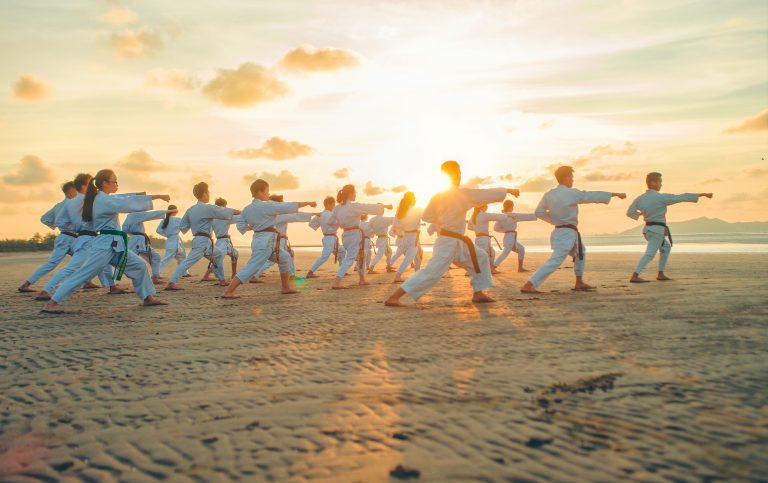When Was Karate Made? A Historical Account of the Origins and Evolution of Karate
Karate is a martial art that originated in Okinawa, Japan. It is believed to have evolved from the indigenous fighting styles of Okinawa, which were influenced by Chinese martial arts. Over the years, Karate has undergone significant changes and has become one of the most popular martial arts in the world. In this blog post, we will take a closer look at the history of Karate, including when it was made, its evolution, and its impact on modern martial arts.
The Origin of Karate
The origin of Karate can be traced back to Okinawa, which was an independent kingdom until it became a part of Japan in the late 19th century. The warriors of Okinawa were trained in various fighting techniques that were influenced by Chinese martial arts, such as Kung Fu. These fighting styles were known by different names, such as Tode, Ti, and Te.
It is believed that the word „Karate“ was first used to describe a martial art in the early 20th century. The word „Karate“ comes from the Japanese words „kara“ (meaning „empty“) and „te“ (meaning „hand“), which together mean „empty hand.“ This term was used to describe a fighting technique that did not require weapons.
The Evolution of Karate
Karate underwent significant changes in the 20th century. It was introduced to Japan in the 1920s, where it was further developed and refined. It was during this time that the first Karate schools, known as „dojo,“ were established.
In the mid-20th century, Karate became increasingly popular in the United States, thanks to the efforts of individuals such as Bruce Lee and Chuck Norris. Karate schools started to proliferate across the country, and the sport gained recognition as a legitimate form of martial art.
Karate in Modern Times
Today, Karate is practiced by millions of people around the world. It is recognized as an Olympic sport and is an integral part of popular culture, thanks to movies and TV shows that feature Karate and other martial arts. Karate has also influenced other martial arts, such as Taekwondo and Kickboxing.
Despite its widespread popularity, Karate remains deeply rooted in tradition and discipline. Practitioners of Karate learn not only the physical techniques but also the philosophy behind the martial art, such as self-discipline, respect, and humility.
When was Karate Made?
Introduction
Karate is a martial art that originated in Okinawa, Japan. It is composed of various techniques involving kicks, punches, strikes, and blocks that are executed with deadly precision, making it one of the most popular martial arts globally. However, the question remains, when was karate made? Some people say that karate has been around for centuries, while others believe it was only created a few decades ago. In this article, we will answer some of the most frequent asked questions regarding the history of karate and its origins.
What is the Origin of Karate?
The origin of karate can be traced back to the Ryukyu Kingdom, which is now known as Okinawa, in Japan. The Ryukyu Kingdom comprised a group of islands located between Japan and Taiwan. During the 17th century, the Ryukyu Islands were invaded by Japan, introducing the art of Kenpo to the Ryukyu people. Kenpo is a martial art that primarily focuses on punches, kicks, and strikes. However, it wasn’t until the 20th century that karate began to take its current form.
When was Karate created in its current form?
The current form of Karate was primarily developed during the 20th century. In 1922, the first karate school was opened in Japan by Gichin Funakoshi, who is often referred to as the father of modern karate. Funakoshi formulated a new way of teaching karate, which included new techniques and introduced katas, which are pre-arranged forms of attack and defense.
Can Karate be traced back to the Shaolin Temple in China?
There is a popular belief that karate can be traced back to the Shaolin Temple in China. This belief is based on the concept that Bodhidharma, a Buddhist monk who lived in the Shaolin Temple, created the martial arts. It is said that Bodhidharma taught the monks various techniques to help them meditate better, but over time, these techniques became martial arts. However, there is no concrete evidence to support this theory, and it is highly unlikely that Bodhidharma created a martial art that would later become karate.
What is Seisan Kata and its Significance in Karate History?
Seisan Kata is a form of karate that was developed in Okinawa, Japan. The kata consists of various techniques, including kicks, strikes, and blocks, all performed in a sequence. Seisan Kata is significant in karate history because it was brought to Japan by Chojun Miyagi, who was the founder of a karate style known as Goju-Ryu. Miyagi was one of the first people to teach karate outside of Okinawa, and his style was highly popular with martial arts enthusiasts around the world.
How to Find the Answer to „When Was Karate Made?“
If you’re interested in martial arts, there’s a good chance you’ve asked the question, „When was karate made?“ This is an excellent question, as it’s essential to understand the origin and evolution of karate to better appreciate this martial art’s significance.
In this blog post, we’ll provide a step-by-step guide to help you find the answer to this question.
Step 1: Understand the Origins of Karate
First, it’s essential to understand where karate came from. Karate originated in the Ryukyu Kingdom, now present-day Okinawa, Japan. At this time, there was no formalized martial art in the Ryukyu Kingdom. Instead, the people practiced indigenous fighting systems and Chinese martial arts imported from China.
Step 2: Discover the Influence of Chinese Martial Arts on Karate
During the 16th century, diplomatic relations between the Ryukyu Kingdom and China were established. As a result, Chinese martial arts, particularly those from the Fujian province, began to influence the indigenous fighting systems in the Ryukyu Kingdom. The techniques were adapted, and the Ryukyuans developed their own distinctive style, which they called ‚toudi.‘
Step 3: Learn About the Restriction on Weapons
In 1609, the Satsuma clan of Japan invaded and conquered the Ryukyu Kingdom. To prevent any rebellion, the Satsuma clan banned the use of weapons, forcing the inhabitants to rely on toudi as their primary means of self-defense.
Step 4: Understand the Transition of Toudi to Karate
In the early 20th century, karate was introduced to Japan, where it gained widespread popularity. During this period, many practitioners adopted standardized forms that became the basis for modern karate. However, the native Okinawan term, toudi, was considered to be too foreign-sounding for Japan, so the name was changed to karate.
Step 5: Determine the Exact Year Karate Was Made
While it’s challenging to pinpoint the exact year karate was created, one influential figure in the development of karate was Anko Itosu. Itosu was a teacher who developed a series of kata, prearranged movements that simulate self-defense scenarios, which became widely practiced and popularized karate.
According to historians, Itosu developed his kata in the late 19th century, which is why this era is frequently cited as the origin of modern karate. However, karate’s development is an ongoing process, and it has continued to evolve over time.
Step 6: Further Resources on Karate
If you’re interested in learning more about karate, there are several excellent resources available online. Some of the most popular include the World Karate Federation, the International Traditional Karate Federation, and the International Karate Association.
Final Thoughts
In conclusion, the question, „When was karate made?“ is complicated because karate’s development is an ongoing process that has occurred over several centuries. However, understanding the origin and evolution of karate is essential to fully appreciate and practice this martial art. By following the steps in this guide, you’re well on your way to discovering the fascinating history of karate.
Inhaltsverzeichnis






